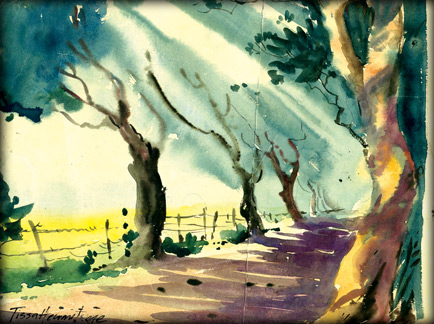Capturing light in watercolour
by Tissa Hewavitarane
The key to an exciting painting lies in capturing the dramatic
effects of strong sunlight in watercolour. The painting reproduced here
shows the sunlight piercing through the trees to the roadway. To suggest
the shifting, moving light, I have used a lot of broken edges trying not
to latch on to individual objects. They'll be an important expressive
element in the painting.
When there is an edge, it will be fairly crisp. You feel a sense of
wonder when looking at something suddenly caught in a shaft of sunlight.
The qualities of tone and colour in the areas hit by the light, compared
to the areas in the shade, are fascinating.
When light falls on any object the colour is bleached out, yet when
it falls through something, the colours glow rich and strong.
 This excites anyone and I have spent a long time looking at the
qualities of lights and darks in these situations. This excites anyone and I have spent a long time looking at the
qualities of lights and darks in these situations.
Thrilling
The more you look at something and try to understand it, the more
thrilling it becomes. Each drawing or painting adds to my level of
understanding and makes me want to look more deeply.
I always work from nature. It allows me to understand exactly what it
is.
I draw only what is important and use that when I need to paint
without getting sidetracked by other irrelevant details.
The problem with effects that I am trying to record is that they are
transient. You never realise how quickly the sun moves until you sit
down to draw its effect on something.
Then it seems that every time you look up it has moved a couple of
inches.
My aim is just to get down the most important bits first, and very
quickly.
First decide what is most important to me about what I am looking at.
It might be the particular shape of a shadow across the area of
light. Here the, distinction between accuracy and details is important.
Accuracy
You don't have to put everything in, but what you do put in, even if
it is just a dot, needs to be accurately placed and drawn.
Having got the most important elements down, the bits that will hold
the whole composition together, then more on to other areas.
Once you have got as much information down usually put the drawing to
develop in mind to make it feel the painting ought to be composed in
terms of shapes, rhythms tonal patterns and negative shapes.
There is always a lot to consider, but the more you can account or
all these elements, the more visually satisfying your painting will be.
A sound painting is made up of beautiful arrangements of values and
colour, and what helps in arranging the shapes is a knowledge of
proportions.
It seems to me that there are those who without any training can come
up with the most unusual arrangements of shapes and values.
Composition
They are so clever in the way they set things down.
How the parts of the painting are arranged on the paper is called
design or composition. And how the painting is put together is really a
matter of personal taste the personal desire of the artist. But there
are certain elements which if put together correctly, will produce a
beautiful pleasing design.The painting shown here is based on light
caught in one instant before it moved on. The real challenge of light is
that it is always moving and what I try to show the light moving around
and changing as the sun becomes lower in the sky. As you progress,
things happen, that dictate your next move, to the whole painting
process is an organic series of decisions. This keeps the painting
alive.
The eye goes to trees along the road and main parts of the painting
travels around from object to object. The eye is always drawn to
striking colours and their inclusion can turn an ordinary subject to a
brilliant painting.
The technical richness of this medium is such that one of the most
interesting techniques that it has is precisely the opening of space. On
the other hand there is a sharp value contrasts. The shadows are shown
in light colour to begin with. In addition, we are looking into the
light of the sunlit road. As a result, the midtones and darks are all
below the middle with just a few warm lights high.
Mood
One of the major ways light creates mood in a painting is through the
key. How, for example, with the lights and darks be distributed in a
picture? Which will predominate? And how will the key relate to the
character of the subjects? You may find the key easier to understand if
you compare the basic black-and-white value scale.
The values in a picture actually affect our eyes very much like
musical notes affect our ears. If there is a predominance of darks in a
picture, the picture is considered to be low in key. And the darks
usually create a brooding, sober, dramatic feeling just as would a piece
of music similarly full of deep notes. If there are a lot of brilliant
whites and light greys in a picture, the picture is said to be high in
key. The elements of design includes line, colour, shape, value, texture
space and form. The ways to put them together are called the principles
of design. The unity, variety propotion and movement must work together,
relate to each other and be satisfying for a design to be good. |

